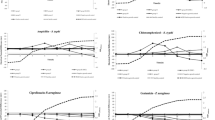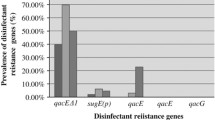Abstract
Recently a new method of antibacterial susceptibility testing has been developed, which based on the reduction of the 3-(4, 5-dimethylthiazol-2-yl)-2, 5-diphenyl tetrazolium bromide (MTT) by bacteria. This study aimed to improve the latest developed method in terms of the period of time, concentration of bacterium, accuracy of assay and minimizing the toxic effect of the MTT solution. The commonly used broth microdilution method was compared in this study, as well. The minimum inhibition concentration (MIC) of the enrofloxacine against Aeromonas hydrophila as an opportunistic and ubiquitous bacterium was tested by using the improved MTT method. Using both methods showed that enrofloxacine exerts an excellent antibacterial effect against A. hidrophyla with MIC value of 62.5 ng/ml. The simplicity of the improved MTT method was shown with performing all steps of the assay in one plate, using rather low concentration of the bacterium (500 CFU/well) and shortening of the incubation time to 9 h. Moreover, 5–30 min incubation of bacteria with MTT solution excludes any toxic effect of tetrazolium salt against bacteria. Thus, our results suggest that enrofloxacine might be considered as a potent antibacterial agent against A. hydrophila induced contaminations. Moreover, MTT method with current improved characteristics such as short incubation time, low concentration of bacteria, and high sensitivity could be more practical alternative for the broth microdilution method in antibacterial susceptibility testing protocol.



Similar content being viewed by others
Notes
Belgium Co-ordinated Collections of Microorganism.
References
Acuna-Villaorduna C, Vassall A, Henostroza G et al (2008) Cost-effectiveness analysis of introduction of rapid, alternative methods to identify multidrug-resistant tuberculosis in middle-income countries. Clin Infect Dis 47:487–495
Bizani D, Brandelli A (2001) Antimicrobial susceptibility, hemolysis, and hemagglutination among Aeromonas Spp Isolation from water of bovine abattoir. Braz J Microbiol 32:334–339
Castro-Escarpulli G, Figueras MJ, Aguilera-Arreola G et al (2003) Characterization of Aeromonas spp isolated from frozen fish intended for human consumption in Mexico. Int J Food Microbiol 84:41–49
Clinical and Laboratory Standards Institute, CLSI (2008) Performance standards for antimicrobial susceptibility testing, 18th informational supplement CLSI document M100-S18. Wayne, PA
Daskalov H (2006) The importance of Aeromonas hydrophila in food safety. Food Control 17:474–483
Iroegbu CU, Nkere CK (2005) Evaluation of the antibacterial properties of Picralima nitida stembark extracts. Int J Mol Med Adv Sci 1:182–189
Isobe I, Yanagisawa K, Michikawa M (2001) 3-(4, 5-Dimethylthiazol-2-yl)-2, 5-diphenyltetrazolium bromide (MTT) causes Akt phosphorylation and morphological changes in intracellular organellae in cultured rat astrocytes. J Neurochem 77:274–280
Ko WC, Lee HC, Chuang YC et al (2000) Clinical features and therapeutic implications of 104 episodes of monomicrobial Aeromonas bacteraemia. J Infect 40:267–273
Ko WC, Chiang SR, Lee HC et al (2003) In vitro and in vivo activities of fluoroquinolones against Aeromonas hydrophila. Antimicrob Agents Chemother 47:2217–2222
Kühn I, Albert MJ, Ansaruzzaman M et al (1997) Characterization of Aeromonas spp isolated from humans with diarrhea, from healthy controls, and from surface water in Bangladesh. J Clin Microbiol 35:369–373
Meletiadis J, Meis JF, Mouton JW et al (2000) Comparison of NCCLS and 3-(4, 5-dimethyl-2-Thiazyl)-2, 5-diphenyl-2H-tetrazolium bromide (MTT) methods of in vitro susceptibility testing of filamentous fungi and development of a new simplified method. J Clin Microbiol 38:2949–2954
Paniagua C, Rivero O, Anguita J, Naharro G (1990) Pathogenicity factors and virulence for rainbow trout (Salmo gairdneri) of motile Aeromonas spp isolated form a river. J Clin Microbiol 28:350–355
Pianetti A, Baffone W, Bruscolini F et al (1998) Presence of several pathogenic bacteria in the Metauro and Foglia rivers (Pesaro-Urbino, Italy). Water Res 32:1515–1521
Raut U, Narang P, Mendiratta DK et al (2008) Evaluation of rapid MTT tube method for detection of drug susceptibility of Mycobacterium tuberculosis to rifampicin and isoniazid. Indian J Med Microbiol 26:222–227
Scoaris Dde O, Colacite J, Nakamura CV et al (2008) Virulence and antibiotic susceptibility of Aeromonas spp isolated from drinking water. Antonie Van Leeuwenhoek 93:111–122
Shi YJ, Chen J, Xu M (2008) A new method for antimicrobial susceptibility testing of in vitro-cultured bacteria by means of resonance light scattering technique. J Microbiol Biotechnol 18:118–123
Soler L, Figueras MJ, Chacon MR et al (2002) Potential virulence and antimicrobial susceptibility of Aeromonas popoffii recovered from freshwater and seawater. FEMS Immunol Med Microbiol 32:243–247
Acknowledgments
The authors are grateful to Dr. Manaffar Ramin for his constructive comments.
Author information
Authors and Affiliations
Corresponding authors
Rights and permissions
About this article
Cite this article
Malekinejad, H., Tukmechi, A., Ebrahimi, H. et al. One step forward to improve the latest method of antibacterial susceptibility testing of vitro-cultured bacteria: an implication for antibacterial efficacy of Enrofloxacine on Aeromonas hydrophila . World J Microbiol Biotechnol 27, 147–151 (2011). https://doi.org/10.1007/s11274-010-0440-5
Received:
Accepted:
Published:
Issue Date:
DOI: https://doi.org/10.1007/s11274-010-0440-5




